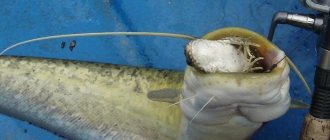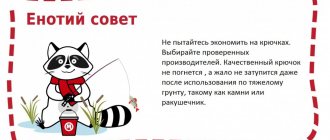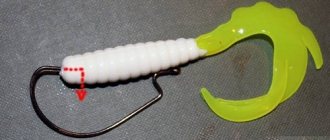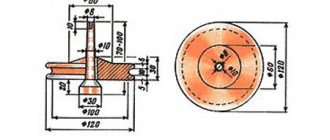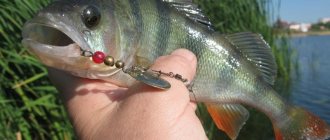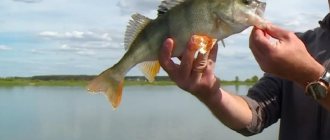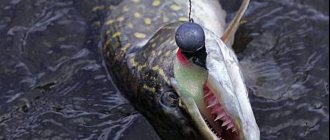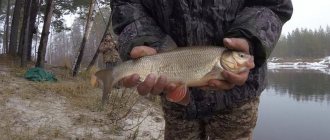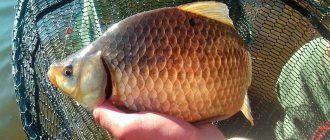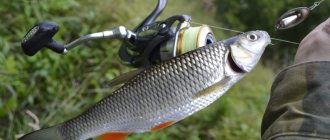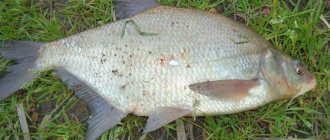Lucky were those fishermen who met such a fish as a snakehead in their lives. The snakehead is unlike any other fish; it is a unique inhabitant of reservoirs with a very impressive appearance. In fact, the snakehead looks more like a reptile than a fish, but it is still a fish, which means it can be caught like any other. Well, or almost like any other.
Catching a snakehead is still different from catching other fish, and this is not at all surprising, because such an unusual fish simply must have a special approach to fishing. This means we need to figure out how to catch a snakehead, what needs to be done for this and what to follow when catching it.
Since the snakehead is a very aggressive and strong fish, you must prepare yourself both mentally and physically to catch it. That is, you must have good gear with which you can withstand the power of the snakehead and force it to surrender after the bite. Well, now let's look at everything in order.
In this article we will look at the most effective way of catching snakeheads, in my opinion - this is catching snakeheads on a spinning rod with surface artificial baits.
Where to catch snakehead
Snakeheads are mainly distributed in hot countries and warm fresh waters. Its main habitats are Africa, East and South Asia, a fairly common fish in Kazakhstan, where it was introduced artificially, but quite successfully took root and reproduced. It is inhabited in some southern water bodies of the CIS countries, including Ukraine - the Dnieper basin and the Ros River, but the snakehead does not really take root in “foreign”, not hot enough places and you need to look for it in warmer countries. As for Russia, fishermen go for snakeheads to Kazakhstan or to the border with China, to the banks of the Amur.
Snakeheads love ponds with slow water exchange that warm up well. He likes shallow areas of the reservoir, especially when the water is well warmed up; he loves overgrown backwaters and changes in depth. The first place to look for snakeheads is in weedy, shallow waters with a muddy bottom. The snakehead attacks bait floating on the surface of the water, which is why it is often called a surface predator.
On the surface of the reservoir in which the snakehead lives, you can see how this fish grabs air from the surface and disappears again under water. The fact is that the snakehead has atmospheric respiration and breathes air, although it also has gills. Using such gulps of air, you can detect the location of the snakehead and provide bait in close proximity to the predator.
When fishing for snakeheads, you have to throw the tackle into the very thick of vegetation, and when fishing from a boat right to the shore, therefore the accuracy of the cast must be honed, otherwise an inaccurate cast will often end in a snag, wasting time and scaring away wary fish. Don’t be afraid to cast into the seaweed or under bushes in the water, because these are the places the snakehead loves. Using surface bait, which we will talk about below, you reduce the likelihood of getting caught on aquatic vegetation to almost zero, and the likelihood of a snakehead biting increases significantly.
Snakehead spawning begins around mid-summer. The female and male snakehead build themselves a nest among aquatic vegetation, which can also be seen on the surface of the water. Usually this is a patch of land cleared of vegetation with a diameter of several meters. Such an area is a very promising place for catching snakeheads, because the fish practically does not leave its home, and if it does, it is not far away. The snakehead protects its offspring - the fry and always tries to keep it in sight.
Snakehead fishing in Kazakhstan
Probably not many anglers can say that they had to catch such an interesting predator as a snakehead. Which is quite understandable, because the snakehead is a heat-loving fish and prefers to live in reservoirs located in relatively warm climatic zones. Therefore, fishing for snakehead
, for example, in the European part of Russia is hardly possible.
The appearance of this predator differs in many ways from the fish we are used to.
The snakehead is very reminiscent of a reptile, and is somewhat frightening to those people who see it for the first time. The snakehead is a strong and aggressive predator, and once hooked, it always resists fiercely. And that means fishing for snakehead
should be carried out using appropriately reliable and powerful gear.
Fishing places
As noted above, snakeheads are heat-loving fish and mainly live in reservoirs in countries with warm climates, in Southeast Asia and Africa. There were attempts to acclimatize it in Ukraine in the Dnieper River, but nothing came of it. But the snakehead has taken root well in the waters of Central Asia, Kazakhstan, Uzbekistan and Kyrgyzstan. In Russia, snakeheads can be caught in the Amur River Basin; a large population of this fish lives in Lake Khanka. However, most often, lovers of catching this fish go fishing in Kazakhstan. Therefore, we will mainly talk about how snakehead fishing occurs in Kazakhstan.
.
Most often, snakeheads inhabit bodies of water where the water is warm enough and water exchange occurs slowly. This predator does not like areas where there is a strong current and where the water cools quickly. After the water has warmed up to the required temperatures, the snakehead appears in shallow water, where there are backwaters overgrown with grass; it can often be found in places with differences in depth. Snakeheads are especially attracted to shallow areas covered with silt. Usually the snakehead hunts for prey that is in the upper layers of the water, and is considered a surface predator.
If a snakehead lives in any body of water, it will not be difficult to find it. Since it comes to the surface at certain intervals, since it is a lungfish, it has gills and organs for breathing ordinary air. This predator can easily spend several days out of water. If a place where a predator is located is found, bait is sent there, and then wiring is done.
Successful snakehead fishing in Kazakhstan
, depends on several factors. First of all, all the angler’s movements must be clear and precisely adjusted. Since hooks are likely, leading to the breakage of baits, if they are not hook-free.
If the angler uses non-hooking baits, the number of hooks will be significantly smaller. When fishing for snakeheads, the bait is often thrown into places where there is a lot of underwater vegetation. If you are fishing for snakehead from a boat, then casts should be made as close to the shore as possible and it is likely that there will be enough interference for the bait there.
Spawning of this unusual predator occurs in the middle of the summer season. The female and male are preparing a nest among aquatic vegetation; such a nest is easy to notice if you carefully examine the grass thickets. Such a nest is an area cleared of aquatic vegetation, several meters in diameter. And if such an area is found, then there is a very high probability that there is a snakehead nearby. This fish is always on guard of its offspring and does not stray far from the nest.
Best fishing time
Like any other fish, snakeheads have their peaks of activity. Therefore, fishing for snakehead
, requires the fisherman to have certain knowledge of his life and habits. They begin to catch this predator in May, and such fishing lasts until mid-October. In May, as the water warms up, the snakehead becomes more and more active.
At this time, he tries to stay in those areas where the water has warmed up better. Most often, these are shallows that attract snakeheads with warm water and where the predator gets its food.
During this period, the snakehead is most often caught from 12 noon, and its bite usually lasts until 20:00. Of course, it can start pecking earlier, and its bite can last longer, but these will only be single bites.
Night fishing for snakehead is also possible.
, however, this requires certain conditions. The most favorable period for catching snakeheads is from mid-June to September. And it bites best in August, when the snakehead is feeding. During this period, he bites on almost all baits offered to him. It is at this time that trophy specimens are caught.
Tackle and bait
Snakehead fishing rod
must have a test weight of at least 100 g. Despite the fact that the bait itself has a relatively small mass, the rod must be reliable and durable. The length of such a fishing rod should be approximately 2.5-2.8 m. From the shore, you can use a fishing rod with a length of 3.2 m. The reel in such equipment should also be powerful and have a margin of safety; it can be either multiplier or inertialess.
Since the snakehead always resists powerfully and stubbornly, the fishing line must correspond to this, it is best to use a braided cord that can withstand breaking up to 40 kg. You can also use high-quality monofilament with a cross-section of 0.4 mm.
are usually caught using spinning baits
. Less often it is caught with a feeder. However, more efficient use of the feeder is expected during the period when the snakehead goes to depths.
Most often, baits such as silicone frog, vibrotail, twister, oscillating or rotating spoons are used to catch snakeheads.
Catching a snakehead on a donk
mainly practiced in the fall, when the predator goes to the depths. The bait is pieces of fish or small fish. But the rest of the time, it’s still better to catch snakeheads with a spinning rod. Moreover, nowadays spinning has become simply a universal tackle and is often used as a feeder. After all, a spinning rod is much cheaper than a feeder rod. Of course, it cannot always be a replacement for a real feeder rod, but it is excellent for snakehead fishing.
As for spinning baits, many anglers believe that snakeheads respond most actively to a silicone frog. This bait is usually cast almost along the surface, and often the angler can watch the snakehead make a throw at the bait.
Before grabbing the bait, the predator strikes it several times. And only after the snakehead grabs the bait with its mouth should the hooking follow. Experts with good experience in hunting this predator recommend that after the predator has struck the bait several times, wait about 20 seconds and only then hook the prey. In this situation, the result is usually always positive.
Retrieving is carried out by quickly winding the reel, and the bait should move along the surface of the reservoir. The bait usually makes noises that attract snakeheads. After hitting the bait, the reeling speed is reduced and the prey is given the opportunity to swallow the bait.
Happy fishing!
When to catch snakehead
Like any other fish, the snakehead has periods of biting and non-biting, bad periods for fishing and feeding. The fisherman must know these time periods and be sure to take them into account if he is going to the pond to catch this fish.
Snakehead fishing lasts during the warm season - from May to October. In May, snakeheads begin to become more active in the area as the water warms up. The snakehead rushes to areas of the reservoir that are well warmed by the sun, in search of warmth and food. The most active snakehead fishing takes place from lunch, about 12 noon, and lasts until 19:00. In the morning and late evening, snakeheads are also caught, but their activity decreases, along with a drop in air temperature.
Snakehead can also be caught at night, and in some reservoirs night fishing for snakehead can be very successful and this predator rushes at the bait with special inspiration.
The most favorable period for catching snakeheads is from the beginning of summer to September, and the peak of this activity occurs in the month of August. In August, the snakehead feeding season takes place and this is the best time to catch the predator. Snakehead bites become more and more greedy and furious, and their frequency goes off scale.
What to catch snakehead with, bait
Cutting off the paws
The main method of catching snakeheads is spinning. But catching this predator is significantly different from catching other predatory fish, this applies to fishing, bait, and fishing techniques.
The following artificial baits are used to catch snakeheads:
- silicone frogs;
- rotating spoons;
- vibrotails;
- oscillating spoons;
- twisters, etc.
Melt with a lighter
It is very good to catch snakeheads on the bottom using live bait or pieces of fish, but anglers more often still use spinning rods to catch this fish, so we’ll talk about the best spinning baits.
The best bait option for snakeheads is a silicone frog. When retrieved, the frog walks from above along the surface of the water, creating a noise that attracts snakeheads; when the fish attacks the bait, this is clearly visible to the naked eye. The snakehead first strikes the bait several times, after which it swallows it. But you can’t rush to hook it; you need to let the snakehead swallow the bait well. In order to increase the likelihood of hooking, it is necessary to count 20-30 seconds after the snakehead hits the bait and only after that make a powerful hook. Then the probability of a snakehead leaving while fishing is practically zero.
Press with fingers
As for silicone frogs for snakeheads, they also work well in store-bought versions. But some fishermen carry out simple modifications and claim that in this way the effectiveness of the bait increases significantly. What is the modification of this bait?
The legs of a silicone frog are cut off. Leaving about 1 cm from them. Since the legs are hollow, you need to melt the edges of the stumps of the legs a little with a lighter, and then squeeze them with your fingers so that they stick together, restoring the tightness of the frog. And a small hole is made in the back of the frog to allow air to escape when the snakehead bites. That's all the simple modification. Which is clearly shown in the pictures on the right.
Wiring for such a bait is very simple. After casting, it immediately begins to reel in the bait quite quickly, leading it along the surface of the water. When the snakehead strikes for the first time, it is better to reduce the speed of the retrieve so that the predator can grab the bait well.
What can you catch?
Snakeheads are not picky and easily fall for live bait. They catch raw fish by slicing it – creating the illusion of movement in the aquatic environment.
For small frogs and small fish attached to a hook. Large earthworms are suitable, but the disadvantage of this type of bait is that they often attract other fish.
When fishing with a spinning rod, large artificial baits are suitable. Any object moving in the thin water awakens the hunting instinct in the snakehead, since these fish are predators.
Rotating spoons, twisters, vibrating tails are good - you can set them on fire with a lighter to create a lively smell.
Snakehead tackle
Snakehead is a very strong fish, its bites are very powerful, as well as jerks during fishing. Therefore, it is advisable to have good, durable tackle when catching this predator. Now we will look at which tackle is best suited for catching snakeheads.
Fishing rod for snakehead . To catch snakeheads you will need a high-quality rod with a weight of 100 grams or more. Although the weight of the bait when catching this fish, of course, will be much less. Such a powerful spinning rod is needed so that the rod can withstand the load when hooking and landing fish. Basically, the snakehead hides in heavily overgrown areas of the reservoir and, after hooking, tries to hide in this grass. Often, the only way to bring a snakehead to shore is to forcefully drag it along with the vegetation. A weak spinning rod may not hold up and break even on the first snakehead.
The length of the rod should be 2.7 meters. When catching snakehead from the shore, you can use a 3.1 meter long spinning rod. With this spinning rod you can deliver bait much further than with a short rod.
Reel for catching snakehead . Ideally, use a powerful baitcasting reel that can easily cope with strong fish, even of record size. But most fishermen cannot afford such expensive gear, so if your budget does not allow you to purchase a good multiplier, take a powerful spinning reel.
Fishing line for snakehead . When fishing for snakeheads, it is best to use a soft braided line with a breaking load of at least 40 kg. You should not underestimate the power of this fish and if you are lucky enough to pull out a small snakehead on thinner tackle, you should not hope for a successful outcome when biting a large predator.
Instead of a cord, you can use monofilament fishing line, but it is advisable to use fishing line with a cross-section of at least 0.4 mm.
Snakehead hooks .
To catch snakeheads with a silicone frog, spinners or wobblers, non-hook tees are used, which allow you to fish heavily overgrown areas of reservoirs and reduce the likelihood of a snag to almost zero.
Interesting facts about the snakehead
- Snakeheads can breathe not only in water but also in the open air. This breathing feature allows them to migrate between bodies of water over land.
- A snakehead can live without water for up to 5 days.
- Snakeheads belong to the order Perciformes.
- The largest species of snakehead is Marulius. This snakehead is distributed from India to China and can grow over 1.2 meters in length.
- Snakehead meat is very tasty.
- Snakeheads are good parents; the nest with offspring is guarded by both the female and the male. No fish will dare to approach the snakehead’s lair.
- The snakehead has no enemies in nature (except humans).
Snakehead habitats
The habitat is constantly expanding. Currently, it inhabits the plains of Uzbekistan, Kazakhstan, Uzbekistan, the Far East, some areas of China, India and some states of the USA. The snakehead is a champion in endurance, it can adapt to almost any conditions - if it gets into a body of water, the local fish in it will have a hard time, if, of course, they stay there. It survives without problems in overseas bodies of water, tolerates drought well, buries itself in silt, can breathe air, moves on land from one body of water to another, and can live for almost five days without water or food.
Read! Secrets of fishing on muddy bottoms
